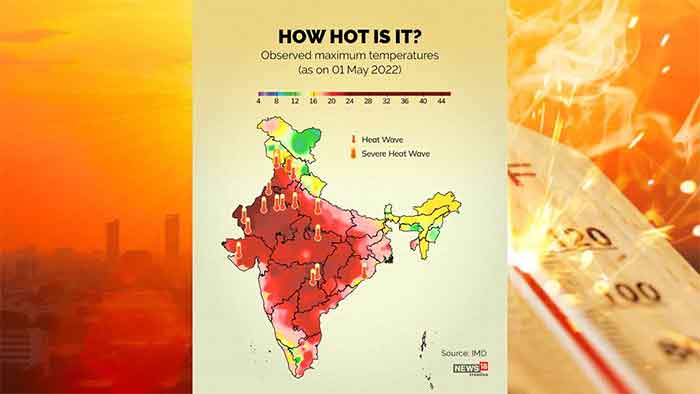
May 15 this year came as a timely warning that India is in the center of the global warming crisis. On this day the maximum temperature crossed the 47 degrees Celsius limit in about 20 cities, mostly in northwest and central parts of the country. These cities also figured in the table of the hottest cities at world level on this day.
Most of these cities and the surrounding countryside have been figuring prominently also in the longer heat waves which have been experienced since early April.
Six of these cities are located in the Thar desert or the area close to it. These include Jaisalmer, Phalodi, Pilani, Churu, Bikaner and Ganganagar.
Four other cities are concentrated in a region of 13 districts known as Bundelkhand in Central India which saw temperature reaching 49 degrees C in Banda. Three other cities of the region which crossed the 47 mark were Jhansi, Naugaon and the tourist resort of Khajuraho.
The third belt in Northwest India included cities like Muktsar, Narnaul, Hisar and Sirsa. Gurugram, home to many multinational companies, crossed 48. Two points in the capital city of Delhi ( Mungeshwar and Najafgarh) crossed 49, even though its base observatory at Safdarjang recorded 45.6.
The base station is located closer to the elitist green areas, with many nice parks, while Mungeshwar and Najafgarh are congested areas with a substantial number of poorer people. It is these people who bear the brunt of heat waves.
While the slums where they live have less greenery are much more congested, they frequently also suffer from higher levels of air and water pollution as well as water scarcity. Open area workers as well as factory workers often work in very hot conditions, and get little respite whether at workplace or living place.
In Bundelkhand I have often seen farm workers toiling in intolerably hot conditions. However those who work there in stone quarries and stone crushers face even hotter conditions, while being exposed also to high dust levels.
In the desert area the scattered hamlets often find it extreme difficult to cope with scorching afternoons, but in addition face increasing water scarcity as well. Camels, who were once the most familiar face of the desert, now are increasingly a threatened species in most villages.
As heat waves intensify in times of climate change, is policy helping to reduce the threat? In recent years Bundelkhand has faced a fierce controversy over a water transfer project called Ken-Betwa Link. This project starts with the felling of over 2.3 million trees at a time when deforestation has been mentioned as a leading cause of water scarcity and worsening drought in Bundelkhand.
The viability of this project has been repeatedly challenged by independent experts who have pointed out that the basic premise of this project of transferring surplus water from Ken river to Betwa river is not justified as the existence of surplus water in Ken river has never been proved. They have pointed out that hundreds of very useful small water conservation projects can be supported instead by the diverting the budget of this expensive Rs.( INR) 450 billion project.
In the scorching summers of this year and the previous year tens of thousands of slum dwellers have been evicted in the course of slum demolitions and in some cases their means of livelihoods like small shops and carts too have been destroyed.
These demolitions have taken place in scorching heat and it is not known where the evicted people are supposed to go. Government promises of rehabilitation often remain confined to uncertain assurances to about one-fourth of those who are evicted. Such demolitions have affected several cities which have figured prominently in heat waves, including Faridabad, Gurugram and Chandigarh. In recent days these have intensified in Delhi. The worst sufferers are mostly poor informal sector workers who have already suffered much recently due to COVID and related lockdowns and earlier due to adverse policies like demonetization.
The poor increasingly ask—where do we go in this savage heat when our homes and livelihoods too are being snatched from us.
The elite however can escape to the hill stations of the Himalayan region. I happened to be close to the hill station of Kasauli as record numbers of tourists poured in from the scorching plains. But the relief from heat they sought was not in sight as several forests were engulfed in flames.
People in Kasauli as well as tourists felt suffocated as the smoke also reached the hotels and restaurants. There was a rush to rescue stranded, endangered people. A helicopter appeared on the horizon to help in extinguishing fire, but appeared to be unequal to the challenge of the leaping flames. An eco-camp was reduced to ashes. Many tourists turned back midway, back to the scorching plains.
Bharat Dogra is Honorary Convener, Campaign to Protect Earth Now. His recent books include A Day in 2071, Planet in Peril and Man over Machine.














































